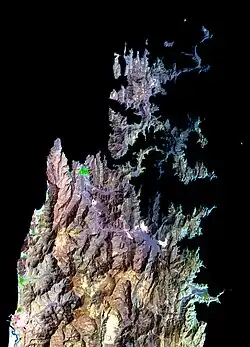Musandam Peninsula
The Musandam Peninsula (Arabic: جَزِيْرَة مُسَنْدَم \ رَأْس مُسَنْدَم, romanized: Jazīrat Musandam / Raʾs Musandam), locally known as Ruus Al Jibal (Arabic: رُؤُوْس ٱلْجِبَال, romanized: Ruʾūs al-Jibāl Heads of the Mountains),[3] is a peninsula that forms the northeastern point of the Arabian Peninsula. It is located to the south of the Strait of Hormuz, between the Persian Gulf and Gulf of Oman.[4] It is inhabited by the Shihuh tribe and is mainly governed by Oman as the Musandam Governorate with certain parts governed by the United Arab Emirates, including Ras Al Khaimah and parts of Dibba.[1][2]
|
جَزِيْرَة مُسَنْدَم رَأْس مُسَنْدَم | |
|---|---|
 The peninsula as seen from space. Al-Khasab to the north (top) shown in green, is contrasted between the more subtle rainbow tones of the surrounding rock in this false-colour image. The term Khasab refers to the fertility of the soil. | |
| Coordinates: 25°54′N 56°12′E | |
| Governorates of Oman and Emirates of the United Arab Emirates | Musandam Governorate (Oman) Ras Al Khaimah (UAE) |
Climate, geology and geography
Land features include the Western Hajar Mountains. Since these are the northernmost of the Hajar range, they and the peninsula are referred to as Ruʾūs al-Jibāl (Arabic: رُؤُوْس ٱلْجِبَال, romanized: Heads of the Mountains).[1][2] The largest wadi in Mussandam is Wadi Bih, which forms the central drainage basin.[5][6]
The highest Mountain in Mussandam, and Ru'us al Jibal, is Jebel Harim, which measures 2,087 m (6,847 ft) from sea level. [7]
During winter, the region can be fairly cool, particularly the mountains of Jais, Yanas (Arabic: يَنَس; 25°44′12″N 56°5′56″E) and Mebrah.[8][9]
 View of the mountains of Musandam, December 1971
View of the mountains of Musandam, December 1971.jpg.webp) View of the Ru'us al-Jibal from Jabal Qiwhi
View of the Ru'us al-Jibal from Jabal Qiwhi The mountainous area of Kumzar, c. 1908
The mountainous area of Kumzar, c. 1908 Sedimentary rock layers near Khasab in Musandam Governorate, Oman
Sedimentary rock layers near Khasab in Musandam Governorate, Oman Jabal ar Raḩraḩ (1,676 m), the UAE's highest mountain, near Ras Al Khaimah
Jabal ar Raḩraḩ (1,676 m), the UAE's highest mountain, near Ras Al Khaimah
Fauna and flora
Fauna include the Ruus al Jibal fan-footed gecko,[10] Arabian tahr and caracal. It is unknown if the Arabian leopard is still present.[1][2]
.jpg.webp) African monarch butterfly (Danaus chrysippus) in Zhighy Bay, Musandam Governorate
African monarch butterfly (Danaus chrysippus) in Zhighy Bay, Musandam Governorate.jpg.webp) Blue basker dragonfly (Urothemis edwardsii)
Blue basker dragonfly (Urothemis edwardsii).jpg.webp) Common mynah (Acridotheres tristis)
Common mynah (Acridotheres tristis).JPG.webp) House sparrow (Passer domesticus)
House sparrow (Passer domesticus)_(12801641984).jpg.webp)
References
- Edmonds, J.-A.; Budd, K. J.; Al Midfa, A. & Gross, C. (2006). "Status of the Arabian Leopard in United Arab Emirates" (PDF). Cat News (Special Issue 1): 33–39.
- Spalton, J. A. & Al-Hikmani, H. M. (2006). "The Leopard in the Arabian Peninsula – Distribution and Subspecies Status" (PDF). Cat News (Special Issue 1): 3–47.
- Thomas, B. (March 1927). Travels in Oman. Visit of B. Thomas to the Musandam Peninsula. 1928. Notes on Shihuh dialects & people, also Kumzaris' [10r]. British Library: India Office Records and Private Papers. p. 9.
- Diba, B. A. (2011). Is Iran legally permitted to close Strait of Hormuz to countries that impose sanctions against Iran's oil?. Cupertino, California: Payvand Iranian-American Website.
- Lancaster, Fidelity; Lancaster, William (2011). Honour is in Contentment: Life Before Oil in Ras Al-Khaimah (UAE) and Some Neighbouring Regions. Berlin, New York: Walter de Gruyter. pp. 3–598. ISBN 978-3-1102-2339-2.
- Allen, Calvin H., Jr. (2016-02-05). "1: Land and People". Oman: the Modernization of the Sultanate. Abingdon, New York: Routledge. pp. 1–8. ISBN 978-1-3172-9164-0.
{{cite book}}: CS1 maint: multiple names: authors list (link) - "Jebel Harim". Wikimapia. Retrieved 15 March 2022.
- Al Serkal, Mariam M. (2019-03-10). "UAE to see cold days ahead, temperatures drop to 2.6°C". Gulf News. Retrieved 2019-03-17.
- Al Serkal, Mariam M. (2019-02-28). "UAE to get 5 days of rain and "significant drop in temperature"". Gulf News. Retrieved 2019-03-17.
- Simó-Riudalbas, M.; Metallinou, M.; De Pous, P.; Els, J.; Jayasinghe, S.; Péntek-Zakar, E.; Wilms, Thomas; Al-Saadi, Saleh; Carranza, Salvador (2017-08-02), "Cryptic diversity in Ptyodactylus (Reptilia: Gekkonidae) from the northern Hajar Mountains of Oman and the United Arab Emirates uncovered by an integrative taxonomic approach", PLOS ONE, 12 (8): e0180397, Bibcode:2017PLoSO..1280397S, doi:10.1371/journal.pone.0180397, PMC 5540286, PMID 28767644, e0180397
.jpg.webp)


